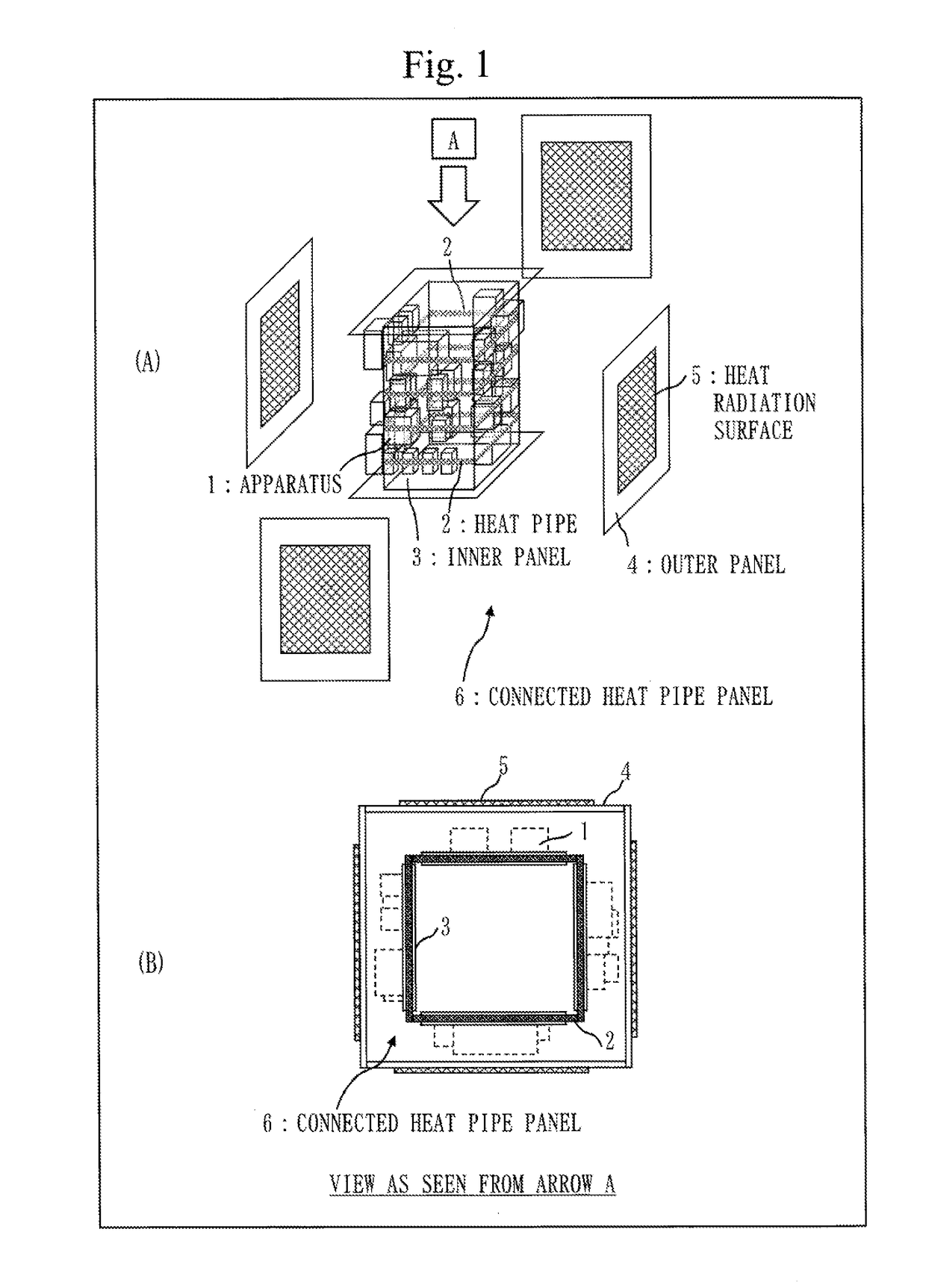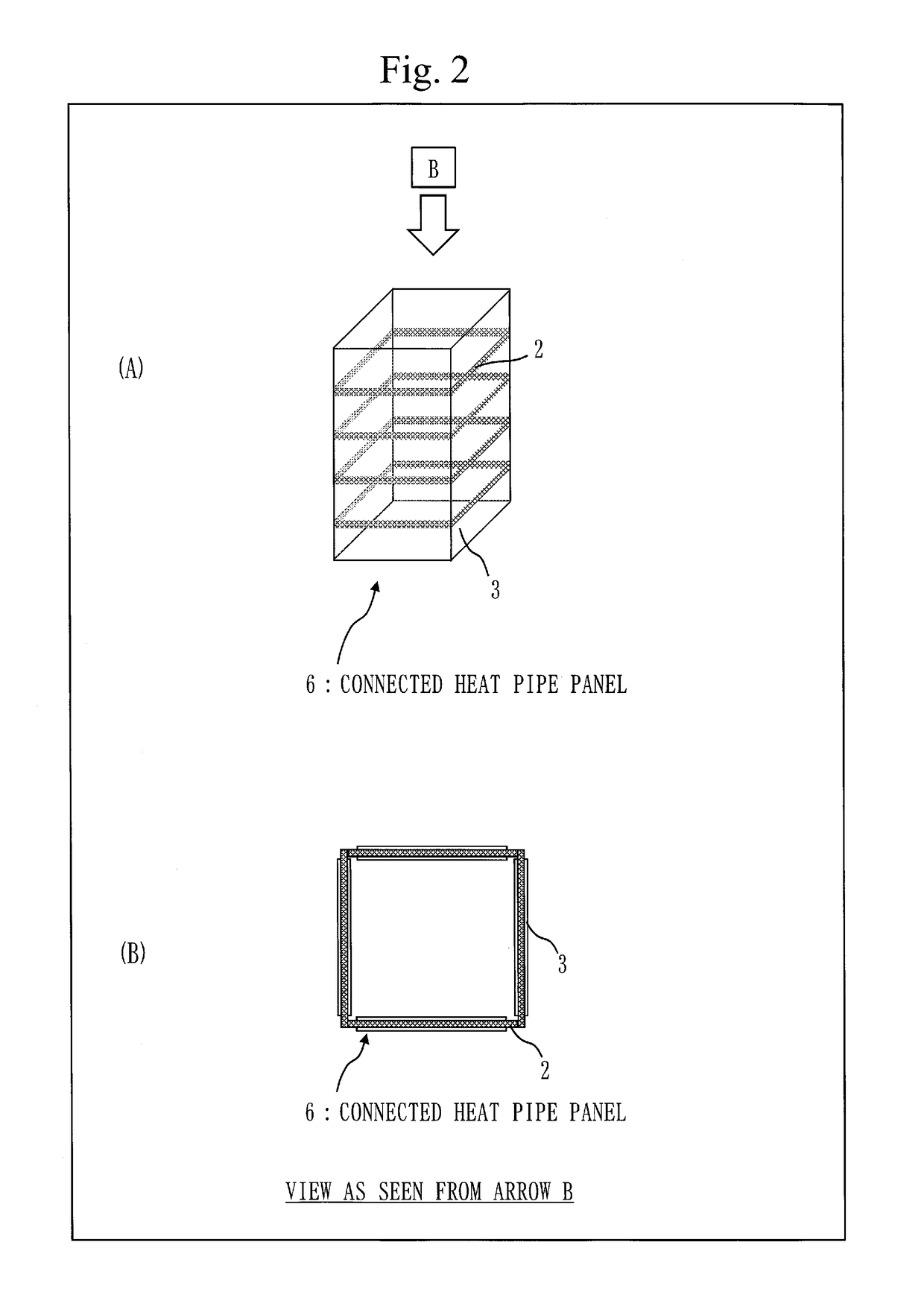Heat radiator using heat pipe panel
a technology of heat pipe panel and radiator, which is applied in the direction of cosmonautic thermal protection, lighting and heating apparatus, cosmonautic vehicles, etc. it can solve the problems of heat radiation problem, difficult to apply the technique of standard satellite bus, and limited mounting area of heat generation apparatus, so as to reduce the temperature and prevent excessive temperature reduction. , the effect of reducing the development period
- Summary
- Abstract
- Description
- Claims
- Application Information
AI Technical Summary
Benefits of technology
Problems solved by technology
Method used
Image
Examples
embodiment 1
[0067]As a heat radiator according to Embodiment 1, a heat radiator having a hexahedral fuselage shape in which a plurality of heat pipes arranged and built in an orthogonal (horizontal) direction with respect to a direction of a fuselage axis (gravity) are connected in a circumferential direction to be isothermal and heat is radiated to the space from heat radiation surfaces provided on outer panels in a connected heat pipe panel having a structure in which inner panels to which apparatuses are installed have four surfaces in a tubular shape will be explained.
[0068]Though a term of satellite will be used in the following explanation, the term of satellite may be replaced with an artificial satellite or a spacecraft.
[0069]FIG. 1 is a structure view of a heat radiator including a connected heat pipe panel 6 according to Embodiment 1. In FIG. 1, 1 denotes apparatuses such as electronic apparatuses mounted on the satellite, 2 denotes heat pipes built in inner panels 3, 3 denotes the in...
embodiment 2
[0081]In Embodiment 2, a heat radiator having a hexahedral fuselage shape in which webbed panels in which heat pipes are built are added with respect to Embodiment 1 and a connected heat pipe panel includes inner panels, webbed panels and heat radiation surfaces provided on the webbed panels will be explained.
[0082]Hereinafter, items different from those in Embodiment 1 will be chiefly explained. Items explanation of which is omitted are the same as those in Embodiment 1.
[0083]FIG. 3 is a structure view of a heat radiator including a connected heat pipe panel 10 according to Embodiment 2. In FIG. 3, 7 denotes heat pipes, 8 denotes webbed panels and 9 denotes heat radiation surfaces.
[0084]FIG. 4 is a structure view of the connected heat pipe panel 10 according to Embodiment 2, in which only the connected heat pipe panel 10 is illustrated from the drawing in FIG. 3.
[0085]The connected heat pipe panel 10 according to Embodiment 2 includes the webbed panels 8 that are radially arranged ...
embodiment 3
[0092]In Embodiment 3, a heat radiator having a hexahedral fuselage shape in which webbed panels and outer panels in which heat pipes are built are added with respect to Embodiment 1 and a connected heat pipe includes inner panels, webbed panels, outer panels and heat radiation surfaces provided on the outer panels will be explained. The embodiment differs from the webbed panel of Embodiment 2 in that the heat radiation surfaces are not provided on the webbed panels in which the heat pipes are built.
[0093]Hereinafter, items different from those in Embodiments 1 and 2 will be chiefly explained. Items explanation of which is omitted are the same as those in Embodiments 1 and 2.
[0094]FIG. 5 is a structure view of a heat radiator including a connected heat pipe panel 14 according to Embodiment 3. In FIG. 5, 12 denotes webbed panels, 11 denotes heat pipes provided in the webbed panels 12 and 13 denotes heat pipes provided in the outer panels 4.
[0095]FIG. 6 is a structure view of the conn...
PUM
 Login to View More
Login to View More Abstract
Description
Claims
Application Information
 Login to View More
Login to View More - R&D
- Intellectual Property
- Life Sciences
- Materials
- Tech Scout
- Unparalleled Data Quality
- Higher Quality Content
- 60% Fewer Hallucinations
Browse by: Latest US Patents, China's latest patents, Technical Efficacy Thesaurus, Application Domain, Technology Topic, Popular Technical Reports.
© 2025 PatSnap. All rights reserved.Legal|Privacy policy|Modern Slavery Act Transparency Statement|Sitemap|About US| Contact US: help@patsnap.com



